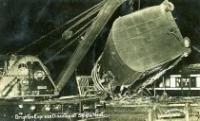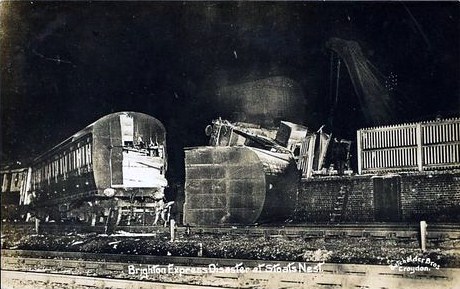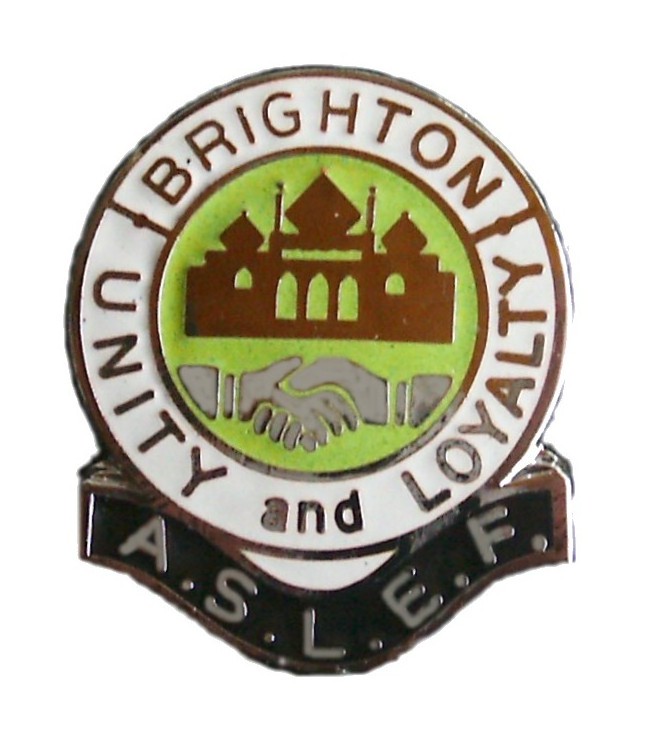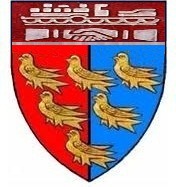ACCIDENT AT STOAT'S NEST
ON THE 29th JANUARY 1910
INVOLVING BRIGHTON DRIVER JOHN THOMPSETT,
HIS FIREMAN IS UNKNOWN
On the 29th January the 3. 40 p.m. up train from Brighton to Victoria, consisting of an engine, tender, and ten vehicles, was
approaching Stoat’s Nest Station, the six rear vehicles of the train were derailed to the left side of the line on which they were
travelling; the leading derailed vehicle, which broke loose from the front portion of the train, was swung broadside on to the
direction in which it was travelling, and in that position came into collision with the ramp of the station platform; this vehicle
was totally wrecked, and five of the passengers who were travelling in it were killed instantaneously, as also were two men
standing on the platform at the time. The five rear vehicles of the train were also derailed, but they were comparatively slightly
damaged, and none of them were fatally injured; 65 of the passengers in the train, however, notified the Company of personal
injuries sustained, but of these only eight were detained in hospital for more than 24 hours, and it is not anticipated that any of
these latter cases will terminate fatally.
The engine of the train was a four wheels coupled tender engine with a leading bogie and one trailing pair of wheels. It was
fitted with the Westinghouse automatic brake, working on the bogie wheels, and the coupled wheels, and the tender wheels, and
it was also fitted with a hand brake working the blocks on the tender wheels.
The train consisted of the following vehicles, attached to the engine in order:-
No. of Weight
Wheels
Brake van No. 368 6 16 tons
Pullman car Albert Victor 8 28 tons
Pullman car Prince 8 28 tons
Bogie third brake 804 8 23 tons
Bogie lavatory third 1325 8 24 tons
Bogie Composite 113 8 25 tons
Pullman car Princess Patricia 12 40 tons
Bogie Composite 525 8 25 tons
Bogie Composite 77 8 25 tons
Bogie third brake 803 8 23 tons
These vehicles were all fitted with the Westinghouse automatic brake, working blocks on all the wheels, with the exception of
the centre pair of wheels of the six wheeled brake van next the tender. The brakes on both the engine and vehicles of these train
are reported to have been excellent order.
The vehicles of the train were all provided with the electric communication apparatus, the application of which rings bells on
the engine and in the guard’s.
PHOTOGRAPHER UNKNOWN
Description
Stoat’s Nest Station is situated on the line, 6 ¾ miles in length, constructed about 10 years ago between Stoat’s Nest and
Earlswood, and which now forms the route for the express traffic between London and Brighton.
The station consists of three platforms, lying approximately north and south, viz., the up local platform on the west side of the
line, the down local through platform on the east side of the line, and the island platform lying between the above. The only
platform however, which is connected with this accident is the one on the east side of the station, viz., the down local through
platform, between which and the island platform lie the up and down local through lines. The up and down main lines do not
pass through the station at all, but run past it close to the back or east side of the down local through platform, the up main line
lying on the west side of the down main line.
There is a signal box, known as the Stoat’s Nest south signal box, on the west side of these up and down main lines, and it is
situated 160 yards to the south of the south end of the down local through platform. At a spot situated 150 yards to the south of
this signal box there is a double junction on the main lines, the facing connection being on the up main line; the two right hand
lines at this double junction continue straight on, forming the up and down main lines, whilst the two other lines branch off
towards the left and run into the station, forming the up and down through local lines.
About 10 yards to south of this double there is a through crossing on the up main line leading from the down main line to some
sidings on the west of the line, and 40 yards to the south of this through crossing there is on the up main line a trailing
connection of a cross over road between the up and down main lines.
The train concerned in this accident was running on the up main line, and was due to run through on that line without passing
through the actual station at all.
The up main line is almost perfectly straight both in approaching, and running past the station, and in approaching the station,
and in approaching the station it is on a falling gradient varying from 1 in 100 to 1 in 125 for just over half a mile.
The permanent way was generally in the neighbourhood of the spot where this accident occurred was found to be in excellent
condition; the rails are bull headed ones, weighing 96lbs to the yard; the fish plates weigh 32lbs the pair, and the chairs 42lbs
each; the sleepers are of the usual dimensions, and there are 18 of them to each 45ft rail length; the ballast is of gravel and
granite chippings. The double junction had been completely relaid with new materials in October 1909.
The facing points of the double junction near the south signal box was fitted with usual safety appliances; it was provided with a
plunger, a locking bar 35 feet in length, and a detector; there was also a treadle fixed about 50 yards a head of the facing points,
by means of which it was rendered impossible for the signalman, after he had lowered his signals, to put the signal lever
completely back in the frame until the train had reached that treadle; it was therefore impossible for the signalman to shift the
points until the engine reached the treadle, and then the locking bar would bar prevent his shifting them until the whole train
was clear of them.
The switches at the facing points were examined immediately after the accident, and were found to be in excellent working order; the only trace
of the derailment to be found on them being that two of the fiver stretcher rods were slightly bent. The guage of the line at the actual point of the
switches was practically correct, but ahead of the points it was slightly tight to gauge, it being the Company’s custom to make the gauge of the
line a quarter of an inch tight at the crossing. These facing points were laid in new in October, 1909, when the double junction was relaid
It should be note that the curve portion of the up local line ahead of the facing points has a check rail fitted on the inside of its
left hand rail; this check rail, which commences at a spot 34 feet ahead of the facing points, has its end secured at that spot to
the left hand rail of the up main line.
The following are respective distances of the various signal boxes referred to in this report from the Stoat’s Nest south box:-
1, Star Lane box, 1 mile 66 chains south of the south box.
2, Cane Hill box 53 chain south of ditto.
3 Stoat’s Nest central box, 21 chains north of ditto.
4, Stoat’s Nest north box, 41 chains north of ditto
On the line between Stoat’s Nest and Earlswood there is a covered way and two tunnels, and the following particulars show
their respective positions and lengths:-
Stoat’s Nest Junction south signal box to the north end of Cane Hill covered way, 14 chains, 63 links.
North end of Cane Hill covered way to south end of ditto 13 chains 78 links.
South end of Cane Hill covered way to north end of Merstham Tunnel 2 miles 28 links.
North end of Merstham Tunnel to the south end of ditto 1 mile 5 chains and 70 links.
South end of Merstham Tunnel to north end of Redhill tunnel 2 miles 29 chains 32 links.
North end of Redhill Tunnel to south end of ditto 27 chains 13 links.
South end of Redhill Tunnel to centre of Earlswood station 46 chains 27 links
The clock of St Anne’s School, which is alluded to by one of the witness is visible when the train is just to the north of the north
end of Redhill tunnel, i.e., at a distance of about 5 ¾ miles from Stoat’s Nest.
.
 PHOTOGRAPHER UNKNOWN
 PHOTOGRAPHER UNKNOWN |
Evidence from the trains driver and the guards John Thompsett, driver, states: I have been over 36 years in the service of the Company, and passed for driver nearly 29 years ago. I came on duty on the 29th January at 7.30 a.m., and was due to come off duty at 7.20 p.m. we arrived at Brighton at 1 p.m., to leave again at 3.40 p.m., so that I got an interval of rest at Brighton. I came off duty on the previous evening at 9.15 p.m. I was in charge of the engine of the 3.40 p.m. train from Brighton to London, I had worked the 8.45 a,m. express train from Brighton to London that morning, and brought back the 11.40 a.m. down train from London to Brighton, and I then took the 3.40 p.m. up train to London. I had had the same engine on each of the journeys, but the coaches on these three trains were not the same. My engine was a four wheeled coupled tender engine with leading bogie and a trailing pair of wheels. It was fitted with the Westinghouse automatic brake, working blocks on the bogie wheels and on the coupled wheels, also on the tender wheels, and it was fitted with a hand brake working blocks on the tender wheels. My brakes were in good order. We left Brighton punctually at 3.40 p.m. until reaching Stoat’s Nest, nothing in the least unusual had occurred on the journey. Just after we passed the facing points at Stoat’s Nest. I found that the automatic brake was applied. As near as I can say, my engine was close to the Central box up through home signal when I felt the automatic brake applied. I thought, from the brake being applied, that one of the brake pipes burst, so I told my mate to put the air pump on so as to keep the pressure up. I had a pressure of 80 in the main reservoir, and only 65 in the train pipe, so I turned the Westinghouse handle so as to put full pressure into the train pipe, hoping to be able to get the train on to East Croydon. I found, however, I could not keep the pressure up so thought there must be something else wrong. I accordingly looked back over my side and saw that the train had parted. I stopped my engine then as quickly as I could. I was just down below the north box when I came to a stand. I found that there were four vehicles attached to my engine. I estimate my speed at the time that the automatic brake was applied at just over 40 miles an hour. There was a speed indicator on the engine, and I looked at it afterwards and found that it registered 40 miles an hour. About mile from Stoat’s Nest Station I had reduced the pressure a little, but did not shut the regulator, only eased it a little. I had not applied any brakes at all on the engine whilst approaching Stoat’s Nest. Before reaching the facing points I noticed nothing unusual with the running of my train. James Wood, guard, states: I have been over 34 years in service of the Company and have been a guard for 33 years. I came on duty on the 29th January at 7. a.m. and was due to come off duty at 5.20 p.m. I was head guard of the 3.40 p.m. up train from Brighton to London, and I joined the train at Brighton. My tain consisted of an engine, tender and 10 vehicles, and I was riding in the fourth vehicle from the engine which was a bogie third brake. The vehicles of the train were fitted with the automatic Westinghouse brake working on all the wheels of the train except the centre pair of the leading brake van. My brakes were in good order. We left Brighton punctually at 3.40 p.m. I should estimate our speed at from 45 to 50 miles an hour when we were approaching Stoat’s Nest. Previous to reaching Stoat’s Nest I had noticed nothing unusual with the running of the train. Just after my vehicle passed the south box I noticed that the rear part of my brake van was shaking about. I myself was riding in |
the front portion of it. The vehicle shook about just for a second and then became steady again. I then looked out and found the
train had parted in rear of my brake van. I then tried attract the driver's attention so as to get him to stop. Just about the same
time that I noticed my vehicle shaking about the automatic brakes were applied sharp. We ran on to the north signal box and
came to a stand there. My vehicle had passed the facing points before I noticed the shaking of my vehicle. Before reaching these
facing points I had notice no shaking whatever in my train. I did not notice any variation in the speed of the train when
approaching Stoat’s Nest nor had the automatic brake been applied at all. The brake had certainly not been applied previous to
my vehicle shaking about. Before leaving Brighton I had myself examined the couplings of the train and I could see nothing in
them defective at all. The train had not stopped at all since leaving Brighton. I do not think there were more than eight people
travelling in the vehicle immediately behind mine. I saw our signals at Stoat’s Nest and they were all off for us, including the
distant. I had very little luggage in my van that day. None of the passengers riding in my vehicle complained of any discomfort
on the journey. I did not hear any grinding of the wheels anywhere on the journey. We had a clear road all the way up from
Brighton – all the distant signals being off for us. We are booked to leave Brighton at 3.40 p.m. and we left at 3.40 p.m. We
were due at Keymer Junction at 3.56 p.m. and we passed at 3.55 p.m. We were due at Three Bridges at 4.11 p.m. and passed
there at 4.10. p.m. We were due at Earlswood Junction at 4.20 p.m. and passed it 4.19 p.m. We were due at Stoat’s Nest at 4.30
p.m. and passed it at 4.29 pm. We picked up a minute in running from Brighton to Keymer Junction and after that we adhered to
booked times until reaching Stoat’s Nest.
James Turner states: I have been in the service of the Brighton Railway Company altogether 24 years and have been employed
as a guard during the whole of that time. I was guard of the 3.40 p.m. up passenger train from Brighton on the 29th January, and
I was riding in the van at the rear of the train. Before starting from Brighton I walked down the train to that all the doors were
closed on the off side of it, and at the same time I examined the couplings. I found nothing wrong with the train. We left
Brighton punctually at 3.40 p.m. On leaving Brighton I noticed nothing unusual with the running of my train. We arrived at
Earlswood at 4.20 p.m., which was our Brighton time for arrival there. I had not, however, to record the times in my book, so I
cannot be certain to a minute or so; but I think that we were punctual at Earlswood. The first I knew of this accident was when
we came out of the covered way, and I felt that the brakes were suddenly applied. I cannot say how far we were from the
covered way when the brakes were applied, as I was thrown down by the shock of their application. I was stunned by the fall,
and I really cannot remember anything more until my carriage had come to rest. Previously to the brakes having been employed
I noticed nothing irregular or unusual in the running of the train. I estimate our speed when we came out of the covered way at
about 45 miles an hour. I did not notice anything unusual roughness in running through any of the connection at Earlswood. Nor
did I notice anything unusual at any of the cross over roads between Earlswood and Stoat’s Nest. I did not notice any fire or
sparks on the train previous to the accident. The brakes throughout my train were in good order; they appeared to go on very
suddenly when they were applied.

Extracts of the Conclusion
The train to which this accident occurred had left Brighton punctually at 3.40 p.m; it had reached Keymer Junction (9 ¾ miles f
rom Brighton) one minute before its schedule time, and when it reached Stoat’s Nest (35 ¾ miles from Brighton) it was still one
minute before time. It had taken 49 minutes to run Brighton to Stoat’s Nest, which gives an average speed of 42 miles an hour.
The engine of the train was fitted with a recording speedometer, and the speed recorded thereon, on reaching Stoat’s Nest, was
45 miles an hour; this may therefore be accepted as the speed of the train at the time of the accident occurred.
The evidence of the Company’s officials who were on the train does not throw any light on the cause of this accident. Driver
Thompsett states that he had noticed nothing unusual connected with the running of his train until he was passing Stoat’s Nest
Station, when the automatic brake was suddenly applied; he at first though that one of his brake pipes had burst, so he applied
full pressure to the train pipe, hoping to be able to get the train on to East Croydon. This was undoubtedly an error of judgement
on Thompsett’s part, as he should have looked back to make sure that there was nothing wrong with his train. Finding that the
pressure could not be maintained in the train pipe, Thompsett then did look back, and, seeing, that his train had parted, he at
once brought his engine to a stand. Steam was turned on when passing the station; speed had been slightly checked when
approaching it, but the brakes had not been applied at all. Guard Wood, who was riding in the front portion of the fourth vehicle
of the train, states that just after passing the south signal box he noticed that the rear portion of his carriage was shaking about; it
only shook for about a second, and then became steady again; he then looked out, and found that the train had parted in the rear
of his van. He had previously notice nothing unusual in the running of the vehicle in rear of his own.
After the accident the various vehicles of the train were found in the following positions:- The engine, tender, and for leading
vehicles, which had broken loose from those behind them, had run on, and had eventually been brought to a stand near Stoat’s
Nest north signal box, situated just over half mile to the north of the south signal box. From the condition of these vehicles it is
evident that none of them had been off the rails at all, and the only one which had sustained any damage was the fourth vehicle,
a third class brake bogie; at the rear end of this vehicle the coupling was broken, and the draw bar and fixed shackle were found
to be considerably bent to the left, showing that the coupling had been severely strained in the direction before it parted; the rear
left hand buffer rod was also bent in the same direction.
The fifth vehicle of the train, a bogie third class carriage, was found lying broadside across the down through station platform,
about 10 yards from the ramp at its southern extremity. It was in this vehicle that all the passengers who were fatally injured
were riding. It was lying on its side, its leading end being to the west of the platform and over the rails of the up local line, and
its trailing end to the east of the platform and extending over the rails of the down main line. The body of this vehicle was
entirely demolished, though its under frame was intact. Its bogie trucks, which were twisted, were knocked from under it, all its
four axles were bent, and its wheels generally have shifted an inch towards on its wheel seat; the bogie frame adjacent to this
wheel was bulged outwards, and there were four sets of indentations on the adjoining flanges of this frame showing where this
wheel in its revolution had been grinding against them and cutting into them; these indentations bore distinct marks of the metal
having been red hot. The coupling screw at the leading end of the vehicle was broken with a very clean fracture; the draw bar at
that end was considerably bent to the right and the front right hand buffer rod was bent in the same direction. The rear end of
this vehicle was partly uncoupled from the one behind it.
The remaining vehicles of the train were all standing upright, and they were all coupled together. The sixth vehicle a bogie
composite, was standing across the up and down main lines; its leading end had evidently been in severe collision with the
vehicle in front of it, and it had also sustained a number of minor damages, but its axles were not bent, and its wheels were all
found to be correct to gauge. The remaining four vehicles were all derailed to the left of the up main line, and they were found
standing in the six foot between that line and the down local through line. None of these vehicles were seriously damaged,
though the rear bogie of the seventh vehicle a Pullman car was knocked from under it.



